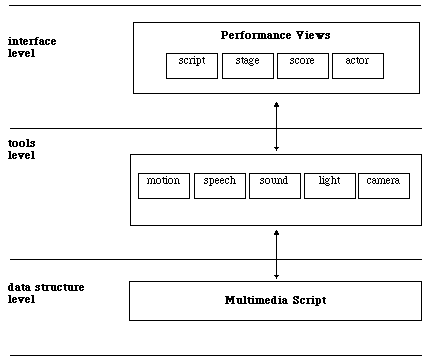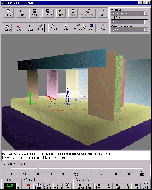Actors playing in Multimedia Scenes
by Patrizia Palamidese
CATS (Computer Aided Theatrical Score) is a 3D graphics system for the composition, synchronisation and simulation in real time of multimedia scenes which include sets, actors' motion and speech, sounds, music, lights, and camera. The initial project developed by CNUCE-CNR in co-operation with Italian theatre directors has been subsequently refined with the support of an Italian company, INTECS, to become an Esprit project funded by the EU IV Framework RTD program. A consortium of European industries, research institutes, and representatives of theatre, TV, and cinema producers, participate in the development of the system. CNUCE is involved primarily in the implementation of the actor motion component.
Theatre is the very first multimedia system because a theatrical scene is a composition of different elements such as motion, speech, lights. Theatre directors and professionals have long been composing and synchronising such sub-systems, first on paper (scripts, and then on stage (rehearsals). We thus chose the theatrical scene as a model on which to build any kind of scene for any type of application. TV shows, film scenes, external events held in town squares, or sports events can all be derived from this basic model.
The CATS system makes it possible to create a rapid sketch of a scene and memorize the structure of a performance as a whole. The main features of the system are the capability to design a scene very quickly and to obtain a real-time simulation on a PC platform. The written script or screenplay is immediately transformed into a digital model or multimedia script for rapid evaluation and modification. The system provides many views of a performance, which are completely integrated and kept consistent on the screen over time. In this way, the user is given the opportunity to intervene and create new performances and/or change existing ones.

Figure 1: Overview of the architecture.
The main environment is the virtual stage which is a window open on time: it can either display the still image of the set at a given time or visualize a real-time simulation within the chosen interval. Following a virtual rehearsal approach, the director can cue in a new actor at any time, suggest a movement or a line, make a run for evaluation, and change parameters such as motion speed or speech intonation. Actor motion is based on high level procedures which mean that the user is released from having to perform a time consuming motion specification. Flexibility is determined by the capability of combining motions and adapting them to any new spatial/temporal situation.


Figure 2 +3: The stage (left) and the score (right) present different
points of view of the scene.
A symbolic visualization of the scene can be obtained: all the elements are drawn on horizontal tracks which are parallel to the timeline, much like a musical score. Symbols can be moved to make different alignments and to control synchronisation. When an actor or a motion is inserted into the virtual set, its symbol automatically appears on the score. To check the structure of the performance as a whole, one can visualize the script to display such elements as acts, thematic blocks, scenes, actor lines, etc, and their links.
Please contact:
Patrizia Palamidese - CNUCE-CNR
Tel: +39 50 593 226
E-mail: p.palamidese@cnuce.cnr.it
